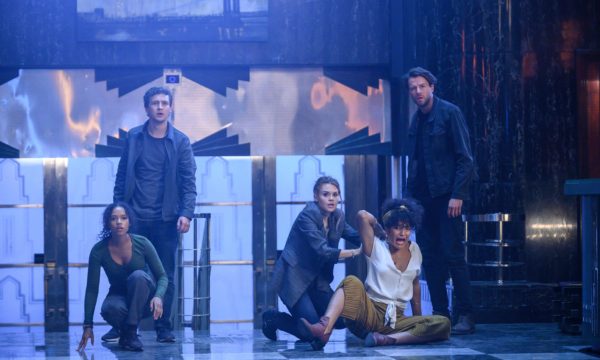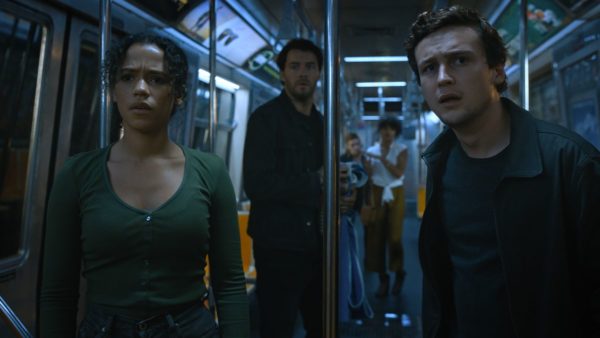
Typically the changes between a theatrical and extended cut are slight. Additional seconds go onto the beginning or end of an existing scene; a deleted scene that offers more exposition or a character beat at the expense of pacing; dialogue trimmed because it’s redundant or repetitive.
Every once in a while, however, the extra content can be illuminating or vital. This is most definitely the case for Escape Room 2: Tournament of Champions, which includes an Extended Cut featuring 25 minutes of new footage, two new characters (played by Isabelle Fuhrman and James Frain) and completely alters the narrative of the film. Minor spoilers follow…
The Theatrical Cut
The sequel, directed by Adam Robitel and written by Will Honley, Daniel Tuch, Oren Uziel, and Maria Melnik, focuses on Zoey Davis (Taylor Russell) and Ben Miller (Logan Miller), the sole survivors of the first film. Zoey has become obsessed with defeating Manos, the shadowy company that developed and profits from the killer escape rooms. In the first film’s closing moments, Zoey zeroed in on a building in New York, so in the opening scenes of the sequel, she and Ben drive to the Big Apple.
Once there they are almost immediately lured into a new series of games along with survivors of other games. The group includes hearing impaired Theo (Carlito Olivero), alcoholic former priest Nathan (Thomas Cocquerel), travel blogger Brianna (Indya Moore), and Rachel (Holland Roden) who has congenital analgesia, a condition that prevents her from physically feeling pain.
The cast is more likeable than the group from the first film and the new rooms, which consist of an electrified subway car, a laser-trapped art deco bank, a sinking sand trap, an acid rain street and a burning attic, are exciting and ambitious. The sequel elevates the stakes and the film leaps into action far quicker because the premise has already been established, so there’s no need for perfunctory exposition.
One small gripe: both Theo and Nathan seem like unlikely survivors considering how slow they are to respond to danger and gameplay. In this capacity the female characters are far more interesting, which may explain why they wind up getting better moments and more screentime.

The Extended Cut
Much of the gameplay involving Zoey, Ben and the others remains the same, but the Extended Cut includes bookended scenes with new characters Claire (Fuhrman) and her father Henry (Frain). In the 2003-set opening, pre-teen Claire and her mother return to their mansion where the mother requests a divorce from a harried Henry, who is busy at work as a Manos puzzle maker. She then meets a grisly end in the steam room as Claire organizes a suitcase full of memorabilia from the day’s journey.
The film then moves into the Theatrical Cut (with a few of the early scenes of Zoey’s therapy sessions excised). When the film shifts to the acid rain scene, the Extended Cut resumes with a vengeance, as Claire becomes Zoey’s co-conspirator in surviving the game and Henry becomes the main antagonist of the film.
What’s fascinating about this new footage is how much it alters the direction of the film. While the resolution of both versions come down to Zoey (re)discovering her agency, the Extended Cut recontextualizes what audiences know about Manos and establishes an exciting new direction for future sequels in a way that the Theatrical Cut doesn’t.
It’s easy to understand why the Theatrical Cut was released: it’s a more streamlined film with better pacing in the first act. It also keeps the focus on Zoey and Ben. Comparably, the Extended Cut pulls focus from Zoey so that she and Claire become joint protagonists by film’s end.

So Which Cut Is Better?
The end of the Theatrical Cut is definitely weaker and requires significantly more suspension of disbelief, though Zoey (and to a lesser extent Ben) remains the central figure. By introducing Claire in the opening, the Extended Cut reframes the narrative around her and Zoey, which pays off significantly in the last act.
The Extended Cut not only offers an exciting direction for a potential third entry, it teases Manos’ larger plan, which is something both the original film and the Theatrical Cut hint at, but fail to substantially deliver on.
Perhaps it’s simply because I saw the Theatrical Cut first, but the Extended Cut feels like the more interesting version of this tale. It truly is a completely different film, which is fascinating and exciting. It’s my preferred Cut because of the new storytelling avenues it opens up, and is well worth picking up the physical release to check out.
My only complaint is that we need an audio commentary or some unique special features by the writers and/or Robitel walking through the new content. While the three featurettes offer some interesting insights, they’re far too brief and only touch on the Theatrical Cut. It’s a big missed opportunity not to have specific bonus content elaborating on the development of both Cuts.
- Theatrical Cut: 3.5/5
- Extended Cut: 4/5
- Bonus Content: 2/5
Escape Room 2: Tournament of Champions is now available on Blu